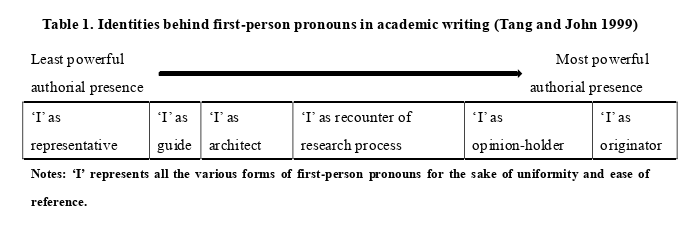联系方式
more本类最新英语论文
- 2024-07-13英汉母语者农科英语论文中第..
- 2024-07-06跃出语言盒子:探究数字化交..
- 2024-06-30操纵论视角下《中庸》两英译..
- 2024-06-21汉英电商营销语言中语用预设..
- 2024-04-09不确定性的确定性-解读《保..
- 2024-03-31空间视域下内勒小说中黑人女..
- 2024-03-26乔伊斯的《都柏林人》中的经..
- 2024-03-18《哈克贝利·费恩历险记》中..
- 2024-03-16个体心理学理论视角下《掘墓..
- 2024-03-14罗洛·梅焦虑理论视角下《拾..
more热门文章
- 2013-09-29上海英语语言学论文题目:从..
- 2011-12-08英语专业英语语言学论文题目..
- 2010-01-26英语语言学论文选题
- 2010-02-02语言学论文参考选题
- 2010-01-07英语论文题目-语言学论文题..
- 2014-05-26英语论文题目-语言学论文题..
- 2010-01-07英语语言文学专业毕业论文题..
- 2010-01-27英语语言学论文选题
- 2010-03-15英语语言学
- 2010-04-16英语论文选题
more留学论文写作指导
- 2024-05-14《反论》(节选)英汉翻译实..
- 2024-05-07《湖泊的一生》(节选)英汉..
- 2024-03-31卡森•麦卡勒斯小说中..
- 2024-03-28美国黑人女性心理创伤思考—..
- 2024-03-27乔治·艾略特《织工马南》中..
- 2024-03-21超越凝视:论《看不见的人》..
- 2024-03-19《哈克贝利•费恩历险..
- 2024-03-13心灵救赎之旅——从凯利的三..
- 2024-02-22文学地理学视角下的《印度之..
- 2023-05-03英、汉名词短语之形容词修饰..
英汉母语者农科英语论文中第一人称代词自我指称语的对比思考 [2]
论文作者:留学生论文论文属性:硕士毕业论文 dissertation登出时间:2024-07-13编辑:vicky点击率:41
论文字数:43666论文编号:org202407081741212812语种:英语 English地区:中国价格:$ 44
摘要:本文是一篇英语语言学论文题目,本研究基于网络语料库平台(HZAU CQPweb),采用定量与定性相结合的研究方法,对比分析代表英语母语者语言使用的期刊论文语料库(JA)和代表汉语母语者语言使用的学习者论文语料库(LP)中农科英语论文中第一人称代词自我指称语we, our, us, I, my, me的频率特征、we和our的搭配使用情况以及第一人称代词所实现的语篇功能。
2.1 Definition and Classification of Self-mentions
The term self-mention first appears in Ivanić’s book Writing and Identity (1998: 46) which illustrates self-mention as “the way authors use first-person pronouns and possessive adjectives (/, me, mine, exclusive we, our, ours) to construct authorial presence”. Hyland (1998) used the term person marker to express the same notion, which contains first-person pronouns I, we, my, mine, and our to show explicit reference to the authors. Furthermore, Hyland (2005: 53) proposed that self-mention is part of interactional metadiscourse and its occurrence frequency can indicate the degree of authorial existence in the texts. On that basis, Liu (2014) gives a clear definition of self-mentions in her research: self-mentions are words used by the writers to refer to themselves in the writings, and finds that they are usually achieved through first-person pronouns.
Self-mentions are classified by researchers and scholars in much the same way. Hyland (2001) suggests that self-mentions include three categories, namely, first-person pronouns in singular and plural forms I, me, we, us, my, and our, third personal nouns the writer and the author, and abstract nouns the paper and the research. Similarly, Liu (2011) puts forward that self-mentions are composed of three components including first personal pronouns, third personal nouns, and non-personal nouns, which follows the classification framework of Hyland (2001). However, Dueñas (2007) assumed that self-mentions primarily include various forms of first-person pronouns, and excluded the third-person nouns and non-personal nouns mentioned in the classifications by Hyland (2002) and Liu (2011). Since Hyland’s (2001) classification of self-mentions has been applied by many researchers, his framework is adopted in this study.
2.2 Discourse Functions of Self-mentions
A great deal of research has investigated the discourse functions of self-mentions in academic writing. Taking Ivanic’s (1998: 307) idea of a continuum of first-person pronouns as the starting point, Tang and John (1999) explored the possible writer roles behind first-person pronouns within academic papers, and classified them into six categories according to the degree of authorial presence as is shown in Table 1.

Chapter 3 Methodology ................................ 17
3.1 Research Questions ................................ 17
3.2 Web-based Corpus Platform: HZAU CQPweb ...................... 18
3.3 Selection of Self-mentions and Corresponding Collocations .......... 19
Chapter 4 Results and Discussion ................................ 24
4.1 Overall Use of First-person Pronouns in Two Corpora ................... 24
4.1.1 Use of First-person Plural Forms we, our, and us in Two Corpora ............................ 27
4.1.2 Use of First-person Singular Forms I, my, and me in Two Corpora ..................................... 29
Chapter 5 Conclusion .......................... 64
5.1 Major Findings ................................ 64
5.2 Implications and Originality .......................... 67
5.3 Limitations 本论文由英语论文网提供整理,提供论文代写,英语论文代写,代写论文,代写英语论文,代写留学生论文,代写英文论文,留学生论文代写相关核心关键词搜索。

 英国
英国 澳大利亚
澳大利亚 美国
美国 加拿大
加拿大 新西兰
新西兰 新加坡
新加坡 香港
香港 日本
日本 韩国
韩国 法国
法国 德国
德国 爱尔兰
爱尔兰 瑞士
瑞士 荷兰
荷兰 俄罗斯
俄罗斯 西班牙
西班牙 马来西亚
马来西亚 南非
南非






